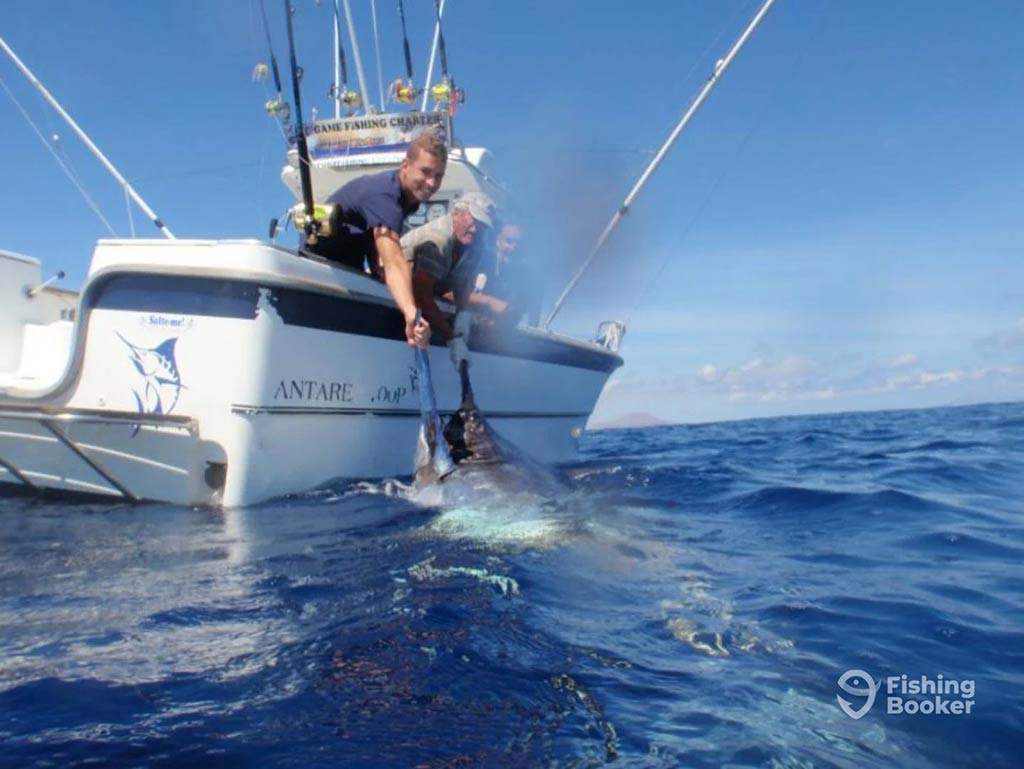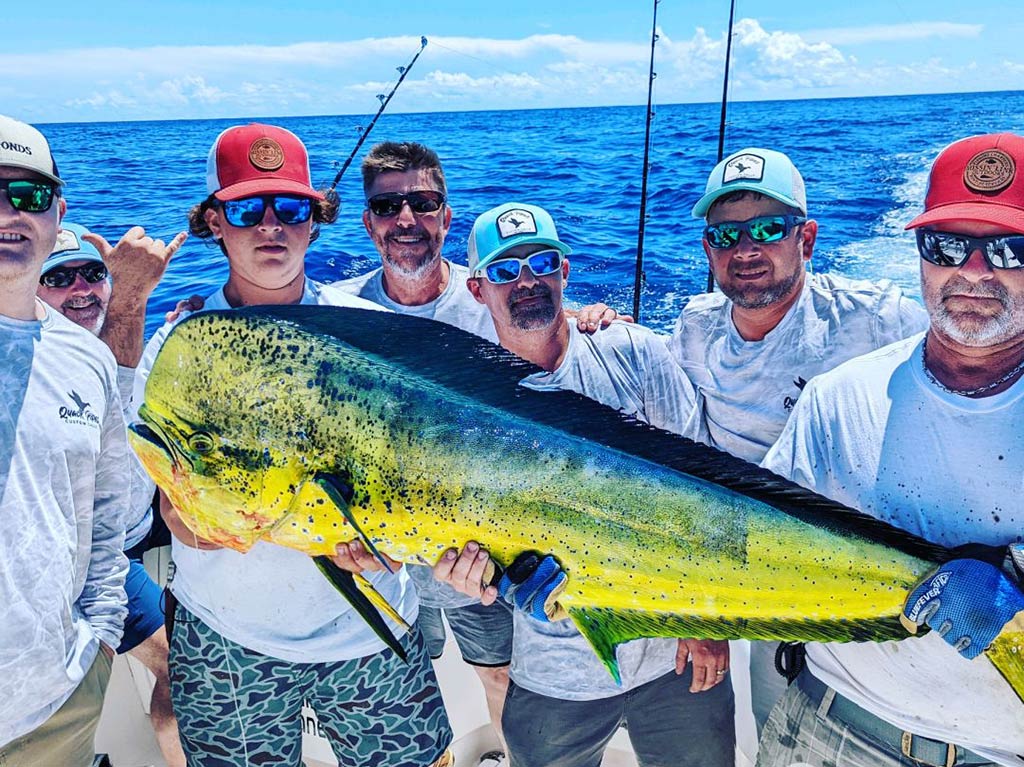There’s no doubt about it: pelagic fish put the “sport” in sportfishing. They’re literally the stuff of legend – from Hemingway’s novel The Old Man and the Sea to the world’s biggest angling tournaments today. If you’re after some true monsters of the deep, these are the fish to hook.

But what sets them apart from other fish? Why are pelagic species such great targets? And which ones are the best? Here’s everything you should know before planning the ultimate pelagic fishing adventure.
What are pelagic fish?
When we trace the meaning of the word pelagic back to its Greek origins, the original pelagos refers to the “level surface of the sea.” Note the word “surface” – that’s key!
Pelagic fish don’t just roam the wide, open ocean (as plenty of other fish do). They swim in the blue water column, which begins roughly 1,000 feet below and reaches up to – you guessed it – the surface.
While we generally think of pelagic fish as saltwater species, plenty of lake-dwelling fish are pelagic as well. Any fish that swim away from the bottom and shoreline are technically pelagic.
Compare that to demersal fish, which spend their lives near the seafloor, and you’ll see a big difference. Where bottom fish are sluggish scavengers, pelagic fish are streamlined predators. Their bodies are designed to carry them long distances, sometimes across entire oceans. And they can travel at high speeds – as much as 60 miles per hour. Needless to say, pelagic fish make for some fast-paced, adrenaline-packed angling.
Top Targeted Pelagic Fish
There’s a whole host of pelagic fish swimming just below the surface. While many are great game fish, not all are created equal. Here’s a look at some of the most popular species that anglers chase around the world.
Blue Marlin

Blue Marlin are the king of pelagics, ruling tropical and subtropical waters of all our planet’s oceans. These formidable predators can grow over 1,000 pounds, with average catches ranging from 200–400 pounds. Known to make fantastic leaps out of the water, they certainly know how to throw their weight around. What’s more, Marlin can swim up to 50 miles per hour.
Bluefin Tuna

Bluefin aren’t just big and powerful – they’re one of the tastiest pelagic fish out there, famous for their sushi-grade meat. Capable of swimming over 40 miles per hour, they roam the Atlantic and Pacific Oceans, with notable fisheries off the Mediterranean, Japan, and US East Coast. Bluefin average 200–600 pounds, but giants may surpass 1,000.
Yellowfin Tuna

When it comes to Tuna, Yellowfin are a close second. They inhabit warm waters around the globe, making them top targets from the US all the way down to Australia. Trophy-sized fish clock in at around 400 pounds, which may sound modest compared to Bluefin – but rest assured, these fish are worth their weight in gold. With bursts of speed up to 50 miles per hour, they’re fast, powerful, and tasty.
Mahi Mahi (aka Dorado/Dolphin)

Averaging just 15–30 pounds, Mahi Mahi aren’t the heaviest hitters out there, but they may be the most beautiful. Their unique shape and bright shades of blue, yellow, and green are unmistakable. They’re aggressive feeders, capable of swimming up to 50 miles per hour and making acrobatic leaps. Having one of these on your dinner table is the cherry on top. Mahi inhabit tropical and subtropical waters worldwide, and you’ll find that they’re a welcome catch anywhere you go.
Wahoo

Long, slender, and painted with stripes, Wahoo are another catch you’re sure to recognize. They’re common in warm waters around the world, most notably off Florida, the Caribbean, and the central Pacific. Given their torpedo-shaped figures, it’s no surprise that these are one of the fastest fish in the ocean. Short bursts can send them blitzing through the water as fast as 60 miles per hour. While Wahoo typically weigh 20–40 pounds, trophies can exceed 100.
Sailfish

Sailfish are yet another iconic catch and, thanks to their sails, truly unmistakable. They lay claim to the Atlantic as well as Indo-Pacific Oceans. Most weigh just 40–70 pounds, which might explain why they can swim at lightning speeds up to 68 miles per hour.
Swordfish

Sticking in the Billfish family, Swordfish are one of the most unique pelagic fish out there. Like their cousins, they reach astonishing sizes, capable of topping 1,000 pounds. They’re also one of the fastest fish, known to make short bursts of 60 miles per hour. However, they dive much deeper than other Billfish, swimming as far as 2,000 feet below the surface during the day. At night, they rise to the surface to feed, making night trips the most effective way of finding them. These nocturnal predators inhabit temperate and tropical waters around the world, with notable fisheries in the Mediterranean and the Florida Keys.
King Mackerel (Kingfish)

They may not be the biggest or the fastest pelagic fish on our list, but King Mackerel are a solid target that anglers love to catch. They’re popular on the Gulf Coast and along the Atlantic, from North Carolina to Brazil. Kingfish can reach 50 pounds, but most average 10–30. Don’t let their size fool you, though. These toothy torpedoes are tough fighters.
Yellowtail Amberjack

Yellowtail inhabit temperate and subtropical waters of the Pacific and Indian Oceans. Notorious for their strength and stamina, they’re one of the most popular targets off the coast of Southern California, and equally popular across the ocean in Japan. Down under, anglers in Australia and New Zealand know them as Kingfish – one of the most sought-after species there is. Though they share a nickname, Yellowtail bear no relation to King Mackerel. They typically weigh 20–40 pounds, but may reach more than 80.
Mako Shark

We couldn’t run through a list of pelagic fish and not mention at least one Shark. And Mako Sharks are more than just fish – and often more than anglers bargained for! These pelagics pop up when fishing for species like Tuna, and they’re also a top target for adrenaline junkies. They’re among the fastest and most ferocious predators across all oceans, capable of reaching over 1,000 pounds and charging at speeds of 60 miles per hour. This allows them to propel themselves right out of the water – and sometimes right into your boat!
How to Go Pelagic Fishing
Fishing for pelagics is a high-speed chase across the bluewater. Here are a handful of techniques you can expect to use for many of the species we outlined above:
Trolling

The most common way of catching pelagic fish is through trolling. This means mimicking fast-moving bait fish by dragging lures or bait behind a moving boat. It’s so popular because it allows you to cover large areas out on the open sea.
The exact speed you should troll depends on your target fish and how quickly they move. Meanwhile, gear like outriggers, downriggers, and planer boards allow you to target fish at various depths. Bait and lure selection also depend on your target species, but some pretty popular choices across the board include diving plugs, plastic squid, and skirted trolling lures.
Live Bait Fishing
As predators, pelagic fish are quick to take an interest in live bait such as sardines, mackerel, or small tuna. You can fish these in a variety of ways, but drifting or free-lining will arguably work best, since these allow your bait to move most naturally. To let your bait swim freely, hook it through the nose or back.
Casting and Jigging

If you’re looking for more of a challenge, casting and jigging with lures requires more work on your part, but that can make that catch of a lifetime all the more rewarding. Start by spotting schools of pelagic fish as they feed near the surface. Floating debris and lots of bird activity overhead are usually signs that you’re getting close! If you plan on casting poppers or surface plugs, focus on a fast, erratic retrieve. When vertical jigging, drop your metal jig below the level where fish are feeding and retrieve up through them using a rapid, rhythmic motion to imitate wounded prey.
Kite Fishing
This predecessor of drone fishing is a unique method that anglers often reserve for Marlin, Sailfish, and Tuna. Kite fishing is especially common off the coast of southern Florida and California. As the name implies, this technique uses a kite to suspend live bait or lures directly on the water surface. It also allows you to fish well away from the boat, which can be key to hooking spooky fish.
Chumming

Chumming isn’t a technique so much as a tool you can pair with any of the above. It involves tossing bits of bait (and sometimes other pungent pieces) into the water in order to draw pelagic fish to you. If there are any nearby, this will create a feeding frenzy in minutes. For a deadly combination, follow chumming with some live bait fishing. Just be sure to only chum in areas where it’s legal to do so.
Pelagic Fishing Gear

We’re talking about the most powerful fish in the ocean – so, naturally, you’ll need to pack some powerful gear. Deep sea fishing charters are well equipped for the challenge, but if you’re tasked with bringing your own tackle, be sure to grab something strong and durable.
Every species calls for something slightly different. Some – like Swordfish – call for very specific gear. But here are some general guidelines to help you get started:
- Rods. Go straight for a medium-heavy or heavy-duty rod with a strong backbone. 6–7′ rods are ideal for trolling, while stronger rods are suited for casting and jigging.
- Reels. Use a conventional or big-game spinning reel with high line capacity and a smooth drag system. Many anglers prefer lever drag reels so they can tune drag pressure during runs.
- Line. You’ll want to use braided line due to its strength and low stretch, usually in the 30–80 lb test range. If you’re targeting trophy fish, make that twice as heavy. Depending on the species, you might add a fluorocarbon leader for abrasion resistance and reduced visibility.
- Terminal tackle. Heavy-duty swivels, snaps, wire leaders (especially for toothy fish like Tuna and Mackerel), and strong hooks are essential. Circle hooks improve hook-ups when live bait fishing and reduce deep-hooking, which allows you to release your catch unharmed.
- Electronics. Lastly, you’ll need some help locating fish in the big, blue sea. This is where fish finders, GPS, and radar come into play.
Top Pelagic Fishing Spots
Despite the size of these fish, finding your target in the vast, blue ocean is a lot like searching for a needle in a haystack. One thing to look for is structure. Though you’ll be fishing near the surface, your target species will be following bait fish, which often gather near seamounts, drop-offs, or floating debris. Try to identify currents or upwellings that stir up nutrients for these fish. When conditions like this are located close to shore, all the better.
Another thing to have in mind is the season. Many pelagic fish are migratory, so finding a good spot for them will only be productive if you fish there at the right time. Nine times out of ten, pelagic species pass through an area during the warmest part of the year.
Pelagic fish of various kinds swim all over the world, but for a true trophy, you’ll want to try your luck in one of the following places:
Southern California

Thanks to the channel islands and some of the Pacific’s deepest canyons, Southern California boasts incredible deep sea fishing. Warm currents in summer and fall push pelagic fish close to shore, including Bluefin Tuna, Yellowtail Amberjack, Mahi Mahi, and the occasional Striped Marlin. These waters are also home to some of the best monster Mako fishing in the world. You’ll find world-renowned charter fleets based in San Diego, Dana Point, Newport Beach, and Long Beach.
Cabo San Lucas

Cabo is famous for its big game fishery, perched right where the Pacific Ocean meets the Sea of Cortez. The area hosts good numbers of Blue Marlin, Yellowfin Tuna, Mahi Mahi, and Wahoo during warmer months. Peak pelagic season runs from May through October.
Costa Rica

The Pacific coast of Costa Rica is renowned for its Marlin, Sailfish, and Mahi Mahi. Warm currents and bait fish attract various pelagics year-round. Peak season here offsets pelagic fishing in many other areas, typically running from December to April. Quepos, Tamarindo, and Golfito are popular launch points for fishing charters.
Hawaii

With warm waters surrounding Hawaii, this famous archipelago hosts Blue Marlin, Yellowfin Tuna, Wahoo, and Mahi Mahi. The Kona Coast, in particular, is famous for deep sea fishing. Head here between May and October for a chance of catching Blue Marlin along with other pelagics.
Florida Keys

The reef edges and deep channels of the Keys are the perfect place to troll for Sailfish, Mahi Mahi, King Mackerel, and Tuna. Thanks to the climate, you can enjoy pelagic fishing year-round. Look for charter boats in Islamorada, Marathon, and Key West.
The Great Barrier Reef

Australia’s Great Barrier Reef is perhaps the only fishing spot in the world more iconic than the Keys. In addition to stunning scenery, it boasts nutrient-rich waters and plenty of underwater structure to draw bait fish in. Fast on their tails are Kingfish (Yellowtail Amberjack), Sailfish, Tuna, Spanish Mackerel, and more. The best season for pelagic fishing runs from October to May, while Cairns and Port Douglas are both famous for their charter fleets.
New Zealand

Many of the same pelagic species, including Yellowtail Amberjack, Marlin, and Tuna, show up in New Zealand, too. November to April marks prime pelagic fishing season for charters based in Auckland, the Bay of Islands, and Tauranga.
Pelagic Fishing FAQs
Pelagic Fish: The Ocean’s Fury

There’s nothing like going head-to-head with the bluewater beasts we described. Their jaw-dropping size and awesome agility make pelagic fishing the most thrilling experience you can have on the open water.
Imagine hundreds – even thousands – of pounds pulling on your line. Picture the blitz that follows at a breakneck speed that can only be matched by the rush of your own adrenaline. And, if you’re fortunate, the feeling that comes with reeling in a once-in-a-lifetime trophy. It’s then you’ll realize you aren’t just hooking a pelagic fish… You’re harnessing the raw power of the ocean.
Have you ever caught a pelagic fish? How long did it take for you to reel one in? We’d love to hear your stories in the comments below!
